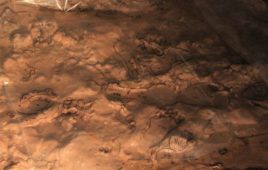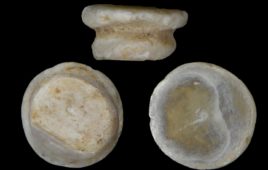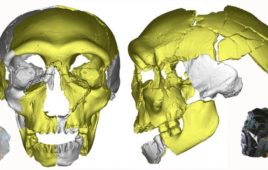 It’s not unusual for researchers to stumble upon the remains of hard body parts, such as skeletons, exoskeletons, and teeth. What is much rarer is finding fossilized evidence of soft tissue. But sometimes scientists during an excavation get lucky. As was the case with a 520-million-year-old crustacean-like animal that was found in southern China.
It’s not unusual for researchers to stumble upon the remains of hard body parts, such as skeletons, exoskeletons, and teeth. What is much rarer is finding fossilized evidence of soft tissue. But sometimes scientists during an excavation get lucky. As was the case with a 520-million-year-old crustacean-like animal that was found in southern China.
With Chengjiangocaris kunmingensis—an early ancestor to modern arthropods—scientists discovered one of the most detailed examples of a nervous system from the Cambrian explosion, a time period when a variety of life burst onto the world stage.
The research, performed by scientists from the U.K., China and Germany, was published in the Proceedings of the National Academy of Sciences.
During observations, the team discovered C. kunmingensis had a nerve cord that ran through its body. Attached to the nerve cord were bead-like ganglia, collections of nerve cells, that each controlled a pair of legs. Dozens of small fibers, roughly five thousandths of a millimeter in length, covered the ganglia.
“These delicate fibers displayed a higher regular distribution pattern, and so we wanted to figure out if they were made of the same material as the ganglia that form the nerve cord,” said co-author Javier Ortega-Hernandez, of the University of Cambridge’s Dept. of Zoology, in a prepared statement. “Using fluorescence microscopy, we confirmed that the fibers were in fact individual nerves, fossilized as carbon films, offering an unprecedented level of detail. These fossils greatly improve our understanding of how the nervous system evolved.”
Part of the animal group fuxianhuiids, C. kunmingensis is described as crustacean-like with a heart-shaped head shield, and a lengthy body that boasted legs of various sizes.
Surprisingly, the nervous system’s structure resembled certain structures seen in priapulid worms and velvet worms. Both had regularly-spaced nerves popping out from the ventral nerve cord. In arthropods, the aforementioned nerves are nonexistent, suggesting that some sort of simplification process occurred evolutionarily.
C. kunmingensis’ nervous system provides scientists a unique view of a nervous system currently unknown in living organisms.
“The more of these fossils we find, the more we will be able to understand how the nervous system—and how early animals—evolved,” Ortega-Hernandez added.
R&D 100 AWARD ENTRIES NOW OPEN:
Establish your company as a technology leader! For more than 50 years, the R&D 100 Awards have showcased new products of technological significance. You can join this exclusive community! Learn more.




